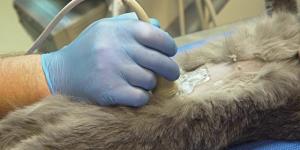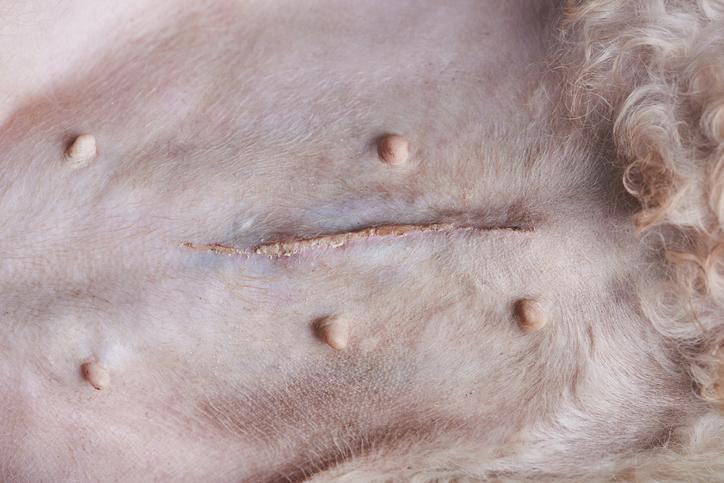How to Tell If a Dog Has Been Spayed



See files for Dogs
You can generally tell if a female dog has been spayed by their spay scars. Since spaying is a surgical intervention, an incision is made on the dog's abdomen. It is these incision scars which indicate a spay. However, there are reasons why this might not provide conclusive confirmation the dog has been sterilized surgically. Sometimes the scars can heal to the point they are faint or are covered in hair which makes them difficult to distinguish. It is also possible the dog has had another abdominal surgery unrelated to spaying.
When we adopt an adult dog, we may not know much about their history. This is especially the case when we rescue a dog which has been abandoned or neglected. When this is the case, AnimalWised helps us to know more about them by finding out how to tell if a dog has been spayed.
Reproduction in female dogs
The domestic dog has a reproductive cycle which has four identifiable stages. Only during one of these stages will the dog be fertile and able to fertilize her eggs. In the other three stages, she will be unable to get pregnant, even if she mates with an uncastrated male. This is a temporary form of sterility which all dogs go through, but is not the same as being permanently sterile which occurs through spaying.
You can learn the specifics of these reproductive stages by looking at our guide to the dog's heat cycle and its symptoms.
The reason spaying makes a female dog unable to reproduce is because her reproductive organs are surgically removed. While there are some variations, the most common form of spaying is an ovariohysterectomy. This is when both the uterus and ovaries are removed. Removing both means they are not only sterile, but they don't produce hormones related to reproduction such as estrogen.
With this distinction in mind, we can see two different kinds of sterilization of female dogs:
- Induced sterilization: this is a form of sterilization which is carried out by a veterinarian to prevent the dog from becoming pregnant. It is usually in the form of an ovariohysterectomy, i.e. spaying. There are alternative forms of induced sterilization such as chemical sterilization with hormone injections, intrauterine devices (IUDs) or fallopian tube ligation. They are not considered as effective and can raise other health issues.
- Physical sterilization: this is a form of ‘natural’ sterilization which occurs due to physical factors affecting the dog. This could be due to congenital malformation, hormonal imbalance of even disease which affects the reproductive organs. While some of these are out of our control, the level of care the dog receives can be an influencing factor in fertility problems.
If you are wondering whether your dog is sterile because they have mated with a male and not become pregnant, it is important to remember that infertility could also be on the side of the male. It is also possible the mating was simply not successful, despite both dogs being sexually intact and fertile.
Discover the best time to spay or neuter your dog with our related article.
How do you know if a dog has been spayed?
When adopting a dog from a shelter, they will likely have determined whether they have been spayed or neutered. They will try to garner as much information from them as they can, although this can be difficult, depending on the individual situation. To determine whether a female dog has been spayed, we need to look at the following:
- Spay scar: the presence of a scar on the abdomen indicates a surgical incision has been made to remove the uterus and ovaries. It can be difficult to discover due to its small size, especially since its appearance can fade over time. The fact the area is usually covered with hair can also make it difficult to determine. You can see a photo of spay scars below to know what to look for.
- No heat cycle: a female dog's heat cycle should begin from 6-8 months of age, with the animal entering her heat period an average of twice a year. This period is easily identified, since bleeding occurs just before her estrous cycle begins. It must be taken into account that older dogs will naturally stop being in heat. Dogs younger than 2 years of age may also not have yet reached sexual maturity.
- Imaging tests: confirmation of whether or not a dog maintains their reproductive organs can be given to us by the veterinarian. This can be performed by various imaging tests, although an ultra-sound is simple, non-painful and minimally invasive.
Spaying is a non-reversible surgery, so there is no chance of the dog becoming pregnant if the procedure was carried out effectively. Not only does spaying make it impossible for the dog to become pregnant, she will also avoid certain health problems related to sex hormones such as pyometra or breast cancer in dogs.
Learn more about how hormones can influence disease with our article on why a dog has swollen breasts.

How to know if a dog is naturally sterile
For dogs that have not been spayed, it is still possible they are infertile. They may still go into heat and want to mate with a male, but there are certain reasons why they are unable to be fertilized successfully. Unfortunately, it can be very difficult to know if this is the case. The following are some natural causes of infertility in female dogs:
- Improper mating: there are some cases where the dog is not actually sterile. However, a problem with mating may mean she does not become fertilized, such as the aforementioned sterility of the male.
- Reproductive malformation: it is possible the dog's reproductive organs never formed correctly and results in them being unable to reproduce.
- Disease: certain pathologies can result in the dog being infertile. These include diseases such as endometritis or cystic endometrial hyperplasia. They can be acquired diseases, but many have a genetic influence which is not always well understood.
- Hormonal imbalance: some diseases may cause a hormonal imbalance, especially endocrine disorders such as hypothyroidism in dogs. Other health conditions can also result in a hormonal imbalance, as well as a side effect of various medications.
At AnimalWised, we recommend spaying and neutering dogs. There are too many dogs in the world without a home or a loving family. Much of this is a result of irresponsible breeding which could be easily avoided. Spaying a dog is also beneficial for the animal since it helps avoid various diseases and extends their life expectancy.
Learn more about the benefits of spaying a dog with our article on whether neutered dogs live longer.
Tests necessary to know if a dog is sterile
To be sure a dog is sterile, we will need to go to a veterinarian. They will be able to carry out a cytology report by taking cell samples from the vagina, cervix or uterus. These cells will be observed under a microscope to determine if there is any anomaly in their behavior. Such anomalies can determine whether the dog is fertile or sterile.
Many cases of infertility in dogs have their origin in irregularities in the reproductive cycle, as we will see in the next section. If abnormalities are detected, it is necessary to see if there is a medically treatable cause, such as an illness. When the illness is treated, it may be possible to reverse their infertile condition. This may require follow up tests such as an ultrasound or hormone analysis.

Irregularities in a dog's heat cycle
Given its importance in how to know if a dog is sterile, in this section we highlight the characteristics of irregular heat cycles in dogs. In doing so, we take into account diseases such as pyometra, brucellosis or canine herpesvirus which can cause infertility or the loss the the dog's puppies through miscarriage. Abnormalities in the canine heat cycle can include the following:
- Silent heat: this is when the dog's heat cycle goes unnoticed because its symptoms are barely noticeable. This makes it possible to think that the dog is sterile. With cytology and a hormone analysis, the exact moment of heat can be determined. This is a type of false sterility.
- Split heat: the dog appears to be in heat, but is actually not receptive. Later the picture is repeated and, in this second case, she is able to accept the male. It usually resolves in the next cycle without requiring any intervention.
- Persistent heat or hyperestrogenism: heat lasts several weeks, during which bleeding from the dog's private area continues. It also usually resolves in the following cycles. There may be an elevation in estrogen levels caused by tumors or cysts. This case would be confirmed with cytology and ultrasound. Surgery may be required to treat the problem.
- Absence of heat: corresponding to a lack of ovulation. Sometimes it can be caused by diseases such as hypothyroidism, ovarian hypoplasia or tumors. Cytology is required and ultrasound can also be performed.
- Irregular heat: occurs when the interval between heats is too short (about 4 months) or too long (more than a year). The causes that justify these irregularities are varied and may include the presence of cysts or diseases such as hypothyroidism. In cases in which heat is repeated frequently, there is no time for the uterus to recover. When this happens, nesting of the embryos does not occur. It is common for problems of this type to be resolved in the following heats, but in some cases medication can be used. If heat does not occur due to premature ovarian failure, it should be noted that there would be no treatment for this case.
We reiterate that spaying your dog is the best course of action both for the individual dog and to help larger populations worldwide. Although there may be complications after spay surgery, they are statistically very uncommon. The benefits outweigh the potential risk, but you can speak to your veterinarian if you have any doubts.

This article is purely informative. AnimalWised does not have the authority to prescribe any veterinary treatment or create a diagnosis. We invite you to take your pet to the veterinarian if they are suffering from any condition or pain.
If you want to read similar articles to How to Tell If a Dog Has Been Spayed, we recommend you visit our Pregnancy problems category.







